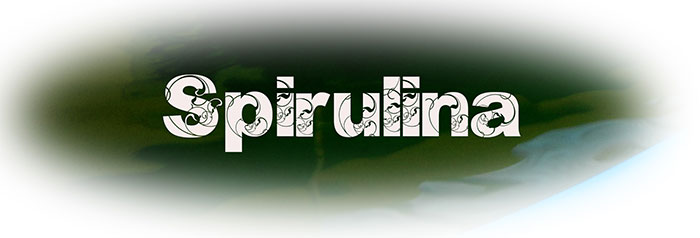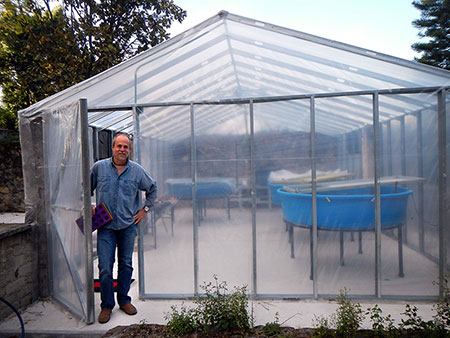|
By John Pint

My neighbor, Rodrigo Orozco, is growing
something green and slimy in four big vats in his back yard. Because he
is also raising 5000
tarantulas (to outfox poachers) I wondered what sort of swamp
creatures I might see crawling out of those vats, but Rodrigo assured
me he was simply helping to reintroduce to Mexico a sort of food
supplement used by the Aztecs and other Mesoamericans before
the Conquista and known to them as Tecuitlatl,
which, I hate to say, Rodrigo translates as “rock poop.”
Now, before you try to leave this page, keep in mind that it was the
indigenous peoples of Mexico who enjoyed the many benefits of Amaranth
and Chía, two amazing superfoods that have only recently been
rediscovered and made available commercially.
Well, here's a third. It's called Spirulina and although it looks like
algae, it's something even more primitive. “I will explain everything,”
said Rodrigo Orozco as he sat me and my wife down on a bench under a
tall oak behind his house.
“Spirulina,” he began, “is a cyanobacterium, one of the oldest living
things that exist on the planet and because it's able to do
photosynthesis, it's green in color. It also produces oxygen, but,
curiously, can only live in a very alkaline environment. Thousands of
years ago, people in Africa and Mexico noticed it. In Mexico, the
Aztecs, especially the runners, consumed it regularly. They harvested
it by sticking long poles into certain very alkaline lakes and coating
the poles with thick Tecuitlatl.
This goo they made into little flat cakes which they dried. These cakes
were common food in those days and are described by Diaz del Castillo
in his book, The
Discovery and Conquest of Mexico.
“Well, the Spaniards didn't like the look of this blue-green slime and
drained many of the alkaline lakes where Spirulina grows naturally. So,
like many other good native Mexican customs, eating Tecuitlatl came to
an end after the Conquista and was forgotten.”
Orozco went on to describe how a curious event brought Spirulina
production back to Mexico centuries later. In the 1970's, he says, a
company called Sosa Texcoco, the biggest producer of sosa cáustica
(caustic soda or lye) in the world, was working in El Lago de Texcoco
and at an international convention, they complained to other colleagues
in the business that they were having problems separating the lye from
a pesky green substance growing in the highly alkaline lake. Hearing
this, a Japanese scientist looked at them and said, “You are fools!
That green stuff is much more valuable than lye. It's Arthrospira maxima,
commonly called Spirulina.”
So, in the early 1970's, Sosa Texcoco gave birth to the company
Spirulina Mexicana, which quickly ended up becoming the world's largest
producer of Spirulina. But the company was a co-op and suffered from
organizational and other problems and eventually went broke. “And
that,” said Orozco with a wry look, was the end of modern production of
Spirulina in Mexico.” Today, he says, the biggest producers are in the
USA, South America and Europe.
 After listening to
this revealing lecture, Rodrigo Orozco led us into a kind of hothouse
with clear plastic roof and walls, which he maintains at a temperature
of 40 degrees C. The Spirulina grows in four large vats full of water
to which chemicals have been added to make it alkaline. “I never have
to replace the water,” he says. “I just keep it moving with pumps.” After listening to
this revealing lecture, Rodrigo Orozco led us into a kind of hothouse
with clear plastic roof and walls, which he maintains at a temperature
of 40 degrees C. The Spirulina grows in four large vats full of water
to which chemicals have been added to make it alkaline. “I never have
to replace the water,” he says. “I just keep it moving with pumps.”
Daylight keeps the Spirulina growing and when it's dense enough, Orozco
runs the water through a silkscreen frame and spoons the green scum
into ice-cube trays which he then freezes. To get your daily ration,
you just drop one cube into a glass of juice and drink up.
“So, what are the benefits of drinking this?” I asked as I plopped a
green ice cube into a glass of jamaica
(hybiscus juice). “Well,” said Orozco, it's merely the richest source
of protein on the entire planet. Beef and soybeans are nothing in
comparison. Then, it also contains all the amino acids that humans
need, as well as iron, calcium, magnesium, Beta-carotene and the entire
B-group of vitamins.”
Orozco says Spirulina gives him energy, regulates his metabolism,
improves his attitude, tones up his immune system and burns away
unneeded body fat. He relates it has made people he knows with cancer
and diabetes much stronger and more able to deal with their problem.
Others say it helps them fight everything from acne to aging.
One of the most
prominent promoters of Spirulina is Jean-Paul Jourdan, a French
professor of History and author of the book Grow Your Own Spirulina.
Fascinated with this miraculous micro-algae, Jourdan spent more than 12
years working on the development of low-cost techniques for Spirulina
production in Africa. It should be noted, by the way, that Spirulina is
the only foodstuff ever approved by the United Nations for fighting
malnutrition. Jourdan demonstrated that people anywhere could make a
hole in the ground, seal it with plastic, fill it with water, and make
the water alkaline with easy-to-find ingredients such as urine and
rusty iron.
While working in Oman, I was shown stromatolites in
the limestone. These I was told were the oldest fossils in the world.
Now, thanks to my enterprising neighbor, I've learned that those
fossils were produced by microbial mats, mostly composed of
cyanobacteria, which, it seems are credited with changing the
atmosphere of the earth hundreds of millions of years ago from 1
percent to around 20 percent, as it is today. So, I can't disagree with
my neighbor Rodrigo when he says, “¡Como la Spirulina, no hay nada más!
– There is simply nothing else quite like Spirulina.
Spirulina
not only comes as ice cubes, but is also available in tablet form. If
you live in Guadalajara or near Lake Chapala, you can get Spiral
Spring brand tablets from Rodrigo Orozco by calling his cell
(33-39-6878-05) and, yes, he does speak English.
|

